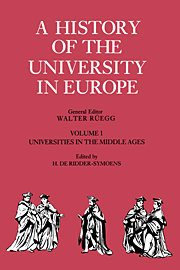Book contents
- Frontmatter
- Contents
- List of maps
- Contributors and editors
- Reader's guide
- Bibliographical abbreviations used in notes
- FOREWORD
- Acknowledgements
- PART I THEMES AND PATTERNS
- PART II STRUCTURES
- CHAPTER 3 RELATIONS WITH AUTHORITY
- CHAPTER 4 MANAGEMENT AND RESOURCES
- CHAPTER 5 TEACHERS
- PART III STUDENTS
- PART IV LEARNING
- THE FACULTY OF ARTS
- EPILOGUE
- Editors' note on the indexes
- Name index
- Geographical and subject index
CHAPTER 3 - RELATIONS WITH AUTHORITY
- Frontmatter
- Contents
- List of maps
- Contributors and editors
- Reader's guide
- Bibliographical abbreviations used in notes
- FOREWORD
- Acknowledgements
- PART I THEMES AND PATTERNS
- PART II STRUCTURES
- CHAPTER 3 RELATIONS WITH AUTHORITY
- CHAPTER 4 MANAGEMENT AND RESOURCES
- CHAPTER 5 TEACHERS
- PART III STUDENTS
- PART IV LEARNING
- THE FACULTY OF ARTS
- EPILOGUE
- Editors' note on the indexes
- Name index
- Geographical and subject index
Summary
Papacy, empire, and schools in the twelfth century
Recent historical studies clearly show that the theory that the imperial authorities intervened directly in higher education from the early twelfth century onwards must be rejected. There is nothing, for example, to show that the University of Bologna was founded at the instance of Countess Matilda of Canossa after her appointment as Vicar of the Holy Roman Empire in May IIII. In the first few decades of the twelfth century not even the church found it necessary to institutionalize the new schools arising in Europe, in spite of the close ties that, from the Gregorian reform onwards, firmly linked ecclesiastical circles with the study of theology and law. The way the schools were organized did not make for closer official relations, for they flourished at a time when the institutional location of education was less important than the personality of a teacher able to attract a group of pupils willing to follow him anywhere. Also, it was widely believed that hankering after riches led directly to the propagation of false doctrine; accordingly, the Councils of Clermont (1130) and Reims (1131) and the second Lateran Council of 1139 solemnly forbade monks and regular canons to study medicine and civil law after taking holy orders and pronouncing religious vows. On the other hand the papal curia did not neglect contacts with the principal schools – the Bologna school of law (Cardinal Aimericus, Chancellor of the Holy Roman Church from 1123 to 1141, was in close touch with the famous glossator Bulgarus) and the school of theology in Paris (in 1144 Cardinal Robert Pullen, an English theologian who had taught in Paris, was appointed Chancellor of the Holy Roman Church).
- Type
- Chapter
- Information
- A History of the University in Europe , pp. 77 - 107Publisher: Cambridge University PressPrint publication year: 1991
- 4
- Cited by

